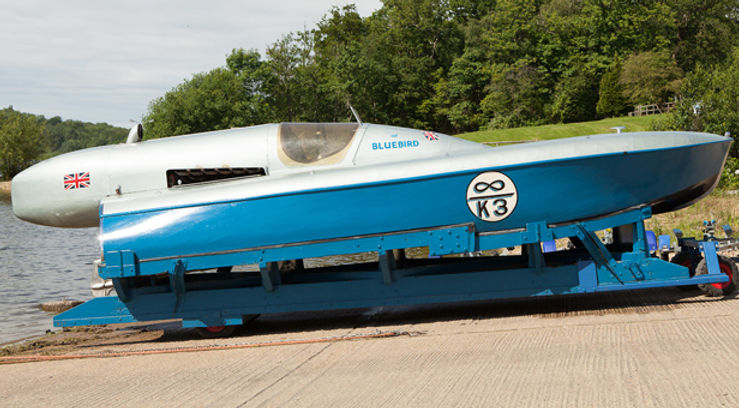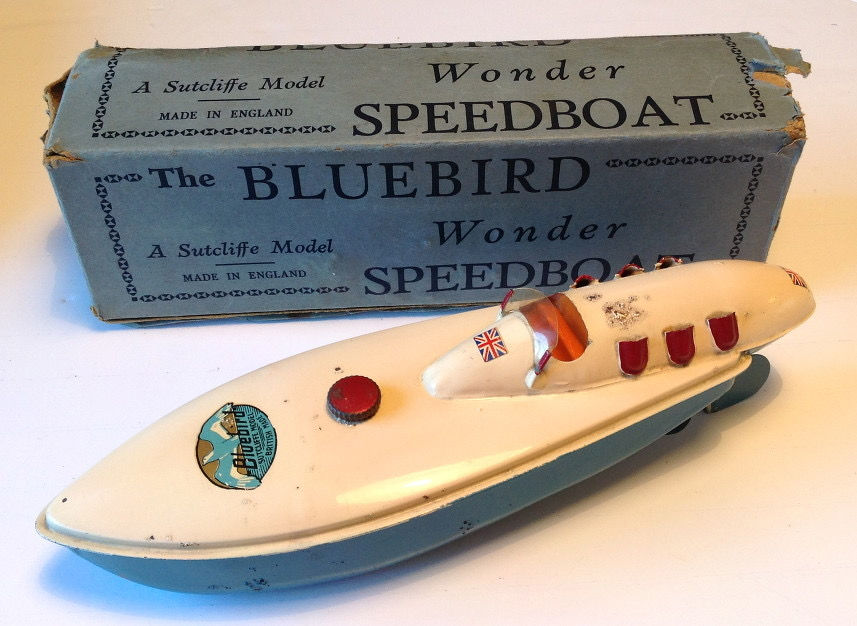Bluebird - 1937 to 1940 and 1948 to 1967
As soon as speedboats started to break records, toy manufacturers quickly realised that toy boats bearing the name of famous record breaking boats would be a hit with the young boys of the 1920's. Manufacturers such as Hobbies, Bassett Lowke and Bing all sold boats bearing the names 'Miss America', 'Miss England' and 'Miss Britain', all famous record breaking boats of the 1920's and 1930's. Most of the models produced didn't even really resemble thier namesakes, but that didnt seem to bother either the manufacturers of the boys!
In 1937, Malcolm Campbell, the famous British speed record breaker took to the water in Bluebird K3, a hydroplane speedboat powered by a Rolls Royce K engine (from a tank!). The boat was to break the water speed record and eventually exceed 130 mph!

The real Bluebird, also known as K3.
Sutcliffe where quick to produce thier version of Bluebird, based on the 9" hull introduced in 1932. Not only did thier rendition resemble the real boat, they were the only toy boat manufacturer to produce a Bluebird K3 toy.

Bluebird Speedboat - circa 1937.
The image above shows an example of a very early Bluebird. The basic 9" hull pressing was extended to the rear with a 'pod' made up of 2 pressings - an upper and lower section. Each side of the pod sports 3 exhaust 'pipes' ; these simple little pressings were taken from previous boats where they had been foredeck vents (eg early RACER 1). The pod also has an aperture for a simple cockpit and a very simple windscreen was attached in front. The windscreen on the early boats consisted of a curved piece of plastic supported by two small soldered stanchions ; this design was later changed to a one piece windscreen surround as the stanchions were very easily damaged. Very few examples of these early models retain both stanchions intact.
The rudder is the same as those used on the other 9" hull boats, but does not have a tiller as there is no space for it! Insteead the rudder is tight on its shaft so can be set to a course.


Bluebird decal - circa 1937. This rather impressive decal did not change in design and was also used on the Bluebird II.
n 1938/39, Bluebird sprouted foredeck vents, presumably to make the model a little more 'interesting', as the real K3 never had these vents!
This permutation of pre-war exhaust ports with deck vents is probably the rarest version of Bluebird produced

Bluebird, circa 1938/39. Note foredeck vents.
When production of boats re-started after the war, Bluebird made the cut and was produced once again, albeit with a few design 'tweaks'. The windscreen design was modified to be a one piece pressing which was slightly stonger,and easier to make - but STILL rather delecate! The separate exhaust pipes were also dropped, in favour of a single 'strip' with three holes; this would have also been simpler to make. The early post war boats also had detail picked out in orange (rather than the pre-war dark red) and came in a simple once piece carton as they did in 1937.

Bluebird - circa 1948. Note revised exhaust pipes and use of orange instead of red. Price 10'6 in 1948.

Bluebirds, 1937 and 1948. Spot the difference!

Bluebird boxes, 1937 (top), 1940 and 1947 (bottom).
The image above shows 3 Bluebird boxes, from 1937 to 1947. The obvious difference is that the repair cost went from 1'9 before the war, to 5'- post war, but close examination reveals another story. In 1937, the text simply states 'post the boat'. In 1940, the text states 'pack carefully and post the boat'. By 1940, Sutcliffe had clearly got a little fed up with receiving badly packed boats in the post, so the text states 'pack corrugated paper around the boat (bold, underlined!) and post direct...". The box also has the text 'pack carefully' printed either side of the title. I would not be suprised if that had considered prefixing the message with the text 'for God's sake!'.....
There is also another noteworthy change; the return address in 1937 was J.W. Sutcliffe, Horsforth, Leeds, but by 1939/40, had changed to Sutcliffe Pressings Ltd. Was John Sutcliffe looking towards the future when he would no longer be running the company?
By approximately 1950, Bluebird would be produced in blue, cream and gold; this is how it would remain for the rest of production. This version is by far the most common version if Bluebird produced.

Bluebird - circa 1950. The boat remained almost identical until the mid 1960's. Vectis Auctions.
Shown below is one of the last versions of Bluebird. It retains its very smart blue/cream and gold livery, but the bung is now plastic and the hull pressing is slightly different. The bow is much 'deeper'; compare to the boat above.

Bluebird - circa 1965.
Production of Bluebird stopped in 1967, but it did have a final 'swansong' in 1978 when Sutcliffe re-produced Bluebird, in limited numbers, for collectors. These final versions, in the expected livery of blue/cream and gold came in simple plain white cartons; if you had bought one of these boats in 1978, you would have almost certainly dealt with Mr Ken Sutcliffe himself.
